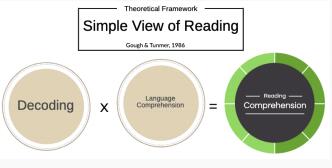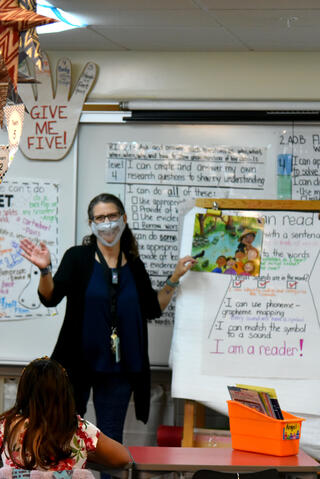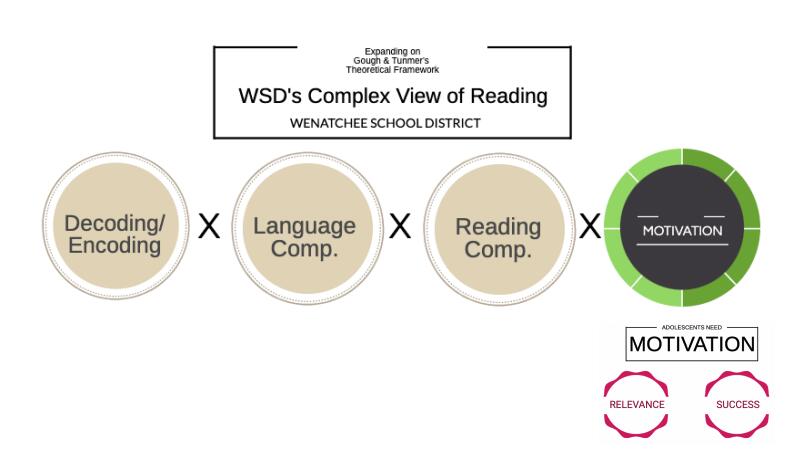
Dr. Staci Bain
By Dr. Staci Bain, Assistant Executive Director of Learning & Teaching
Wenatchee School District Reading Science impACT System
Literacy proficiency in the Wenatchee Valley matters. Educators matter. Instruction matters. Teaching all students, daily, with methodology grounded in peer-reviewed cognitive, linguistics, neurological, and educational research matters.
In the Wenatchee School District (WSD), Superintendent Dr. Paul Gordon is committed to ensuring that our system "firmly plants our instructional flag in the ground of reading science."
What does this mean for the Wenatchee Valley community? WSD scholars? Families? Teachers? Put plainly, WSD is full of reading science practitioners who are striving for all scholars to attain the highest levels of literacy proficiency -- and we are well on our way! WSD educators have transformed their daily classroom literacy instruction to align with the International Dyslexia Association's structured literacy knowledge and practices standards. In our district, we call it impACT. Here is our story of system-wide progress and WSD's shared commitment to reading science instruction.
Beginning in the 2019-2020 school year, WSD provided reading science professional learning sessions for preschool through grade 6 classroom teachers, special education teachers, intervention specialists, instructional coaches, speech-language pathologists, school psychologists, principals, and directors. The professional learning sessions focused on the core conceptual underpinnings of reading science research. The sessions also included modeling of Tier I instructional routines and practices for daily implementation.
What happened as a result of reading science shared learning? A groundswell of teacher implementation and compelling feedback with statements of:
"I'm seeing students spell and write better at mid-year than I've typically seen at the end of the school year." -Lewis and Clark Teacher
"This (reading science) really works. It's given me the boost I needed in this profession." - Lincoln Elementary Teacher
"I wasn't taught this in college, I'm all in." - Columbia Elementary Teacher
A critical component of WSD's quick reading science system reform can be directly attributed to the commitment, hard work, and expertise of classroom teachers, intervention specialists, school principals, instructional coaches, and Dr. Gordon's courageous leadership. Together, WSD has moved reading science to a strategic train-the-trainers model of embedded stakeholder collaboration and support. The model includes:
Classroom Teachers: In grades K-5, educators teach a grade-level reading science routine that  prescribes instruction from phonology to comprehending at-grade level text. This routine is multisensory, explicit, cumulative, and systematic.
prescribes instruction from phonology to comprehending at-grade level text. This routine is multisensory, explicit, cumulative, and systematic.
impACTers: Over twenty district-wide classroom teachers provide reading science modeling and support to colleagues. Some impACTers also provide professional learning sessions within and across the school district.
Lesson Plan Reading Science Writers/Leaders: Ten classroom teachers and an intervention specialist write lesson plans aligning WSD's adopted Wonders curriculum to our reading science (impACT) instructional routine.
Instructional Leaders: Elementary school principals continuously connect with their building's educators to determine needs, support, successes, and opportunities for learning. Principals are routinely in classrooms and partnering with their instructional coach on next steps. As a professional learning community, elementary principals participate in weekly leadership reading science conversations.
Ongoing Professional Learning: WSD continuously creates reading science professional learning to personalize ongoing training sessions to meet educators' most pressing needs. The professional learning content includes peer-reviewed research findings aligned with instructional practices.
So what is reading science and why is it critical to students' success? Let's break it down.
Explicit, direct, multi-sensory, cumulative instruction
Explicit instruction requires direct teaching of concepts. It mandates a lively teaching pace with continuous student and teacher interaction. The interactions between the student and teacher provide ongoing diagnostic evaluation of student proximal development and skill attainment.
Based upon each student's response, the educator immediately supports instruction by providing either more complexity or additional clarification.
Kinesthetic motor movement during direct Tier I instruction provides memory and learning enhancement. Cumulative instruction refers to the purposeful building of conceptual
understandings. In the Wenatchee School District, each elementary grade level reading science routine has embedded kinesthetic motor movement aligned to a cumulative learning scope and sequence.
Phonology and Phonemic Proficiency
Effective instruction incorporates a deep understanding and teaching of overall linguistics (the identification of words within a sentence) to language particles, called phonemes. Phonemes are the smallest unit of speech sound and influence word meaning. Phonology and phonemic proficiency underwrite reading, spelling, and writing. Regardless of age, scholars must
attain competency in this area in order to navigate written language. In the Wenatchee School District, we follow a scope and sequence and monitor the progress of phonemic
proficiency through daily instruction.
Orthography
Alphabetic languages such as Spanish and English follow principles that determine how speech is mapped to print. In the Wenatchee School District, classroom teachers explicitly
teach students how to navigate consonants, vowels, syllables, and multi-syllable words to decode and encode (spell) words.
Morphology
English and Spanish are polyglot languages; meaning, they are derived from other word origins (such as Latin). Words contain meaningful units or morphemes. Teaching the
most frequent prefixes, suffixes, roots/bases/Greekcombining forms, allows students to quickly unlock the meanings of thousands of words. In the Wenatchee School District, we are continuing to learn about morphological awareness instruction.
Reading and Responding to At-Grade Level Text
Daily opportunities read and write in response to grade-level text is critical for literacy proficiency. Intentional teacher support while in text provides every student access to rigorous, complex, meaningful literature.
Where is WSD now, after 14 months of intentional focus on scaling reading science practices?
WSD has reached the critical mass of educator ownership necessary to move literacy mountains. Walk into the majority of elementary classrooms and you will see the explicit, multisensory, direct, cumulative instruction that provides for phonemic proficiency, orthographic mapping, and the assurance of supporting reading comprehension in rigorous text.
Ensuring every scholar reads proficiently is critical to the health of
our community and a daily instructional commitment educators
and leaders uphold.
As stated by the Columbia Elementary educator,
"We are all in."

/WSD-horizontal-logo-small-RGB.png?mask=1)